| Pack
Your Bags: Travelers' Guidebooks
The
first American visitors to Egypt used accounts of the region written
by Herodotus and other classical writers as their travel guides.
By the mid-nineteenth century, American travelers were supplementing
these accounts with travel narratives by British and French writers.
Travelers
also carried with them a host of reading material provided by travel
operators and hoteliers. A wide variety of guides and handbooks
for travelers were soon adding to the baggage carried abroad by
travelers. Additionally, Egyptologists and Biblical scholars were
commissioned to write works about Egyptian antiquities; novelists
wrote fictionalized accounts of life in Egypt which many travelers
carried with them to while away the time spent aboard their dhahabîyehs;
and noted explorers and archaeologists provided scholarly (but not
too scholarly) introductions to the antiquities found along
the Nile.
Included
here is a selection of materials from Smithsonian collections that
travelers may have taken with them on their tours.
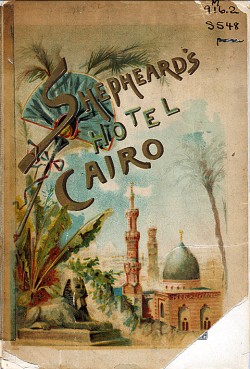 |
Cairo
and Egypt: A Practical Handbook for Visitors to the Land
of the Pharaohs
Cairo, [ca. 1897-1917]
Cooper-Hewitt, The National Design Museum
Library |
Shepheard's
Hotel (Cairo, Egypt)
Cairo's
Shepheard's Hotel figures prominently in many travel accounts.
The prime stopping place for visitors to Egypt from its opening
in 1845, one of its many distinguished guests was Charles
Lang Freer, an American industrialist and art collector who
later donated his collection of Asian art to the Smithsonian.
By 1909, Freer wrote of the addition of other accommodations
in Cairo:
Tell Louise that old Shepheards remains as dirty and attractive
as ever, but new hotels and buildings have sprung up like toad
stools since her time, and now, in summer, are empty and ghostly
as the ancient ruined mosques.
C.L. Freer to Colonel Hecker, Shepheard's Hotel, Cairo, July
28, 1909 This
early guidebook to Egypt, published for guests staying at
the hotel, contains maps, site plans, and general tips for
travellers. The original building was destroyed in 1952, and
the New Shepheard's Hotel, still in operation, opened in 1957. |
|
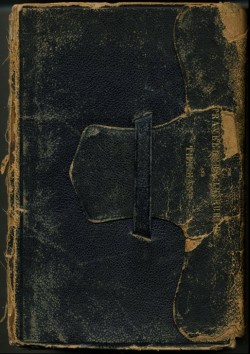 |
Harper's
Hand-book for Travellers in Europe and the East
New York, 1871
Museum
Studies & Reference Library |
William
Pembroke Fetridge
This
"all-in-one" volume was designed for the American
traveler who made a tour of Europe before setting off on a
Nile adventure. Well-stocked with maps, plans of archaeological
sites, and hotel information, the pliable leather binding
with flap enclosure helped to protect the contents from the
vagaries of nineteenth-century travel.
This
well-worn edition was carried on her travels by Lucy H. Baird,
daughter of the Institution's second Secretary, Spencer F.
Baird. |
|
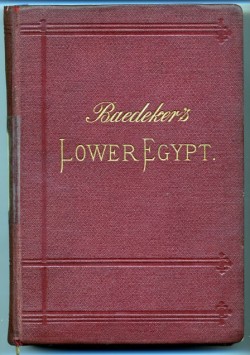 |
Lower
Egypt: Handbook for Travellers
Leipzig: Karl Baedeker, 1885
Cooper-Hewitt, The National Design Museum
Library |
Karl
Baedeker (Firm)
Baedeker's
little red Handbooks have been a staple in travelers'
luggage since the early nineteenth century. The publisher's
first guide to Egypt appeared in 1878, with contributions
from noted Egyptologists Georg Ebers and Samuel Birch. The
maps and plans in the Handbook were based on the work
of German archaeologist and explorer Richard Lepsius, among
others. Baedeker originally devoted two volumes to Egypt,
with volume one covering "Lower Egypt" (the area
around the mouth of the Nile, including Alexandria, Cairo,
the Giza pyramids, and the sites of the Sinai peninsula) and
volume two devoted to "Upper Egypt" (Nubia and the
area south to Aswan and the Second Cataract). As travelers'
itineraries extended to encompass the entire area, Baedeker
condensed the two volumes into one in 1902.
The
introduction to the 1885 Handbook promotes Egypt to
adventurous Western travelers:
Owing to its distance from the homes of most travellers,
and to the expense involved in exploring it, Egypt will
never be overrun by tourists to the same extent as Switzerland
or Italy .... [but] its unrivalled attractions abundantly
reward the enterprising traveller.
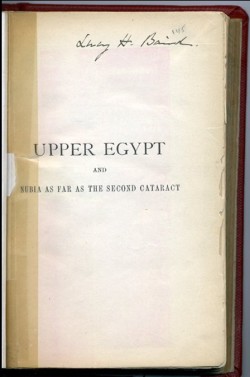 |
Egypt:
Handbook for Travellers
Upper Egypt, With Nubia as Far as the Second Cataract
and the Western Oases
Leipzig: Karl Baedeker, 1892
Anthropology Library |
The
1892 edition displayed here was owned by Lucy H. Baird, daughter
of the Smithsonian Institution's second Secretary, Spencer F.
Baird.
|
|
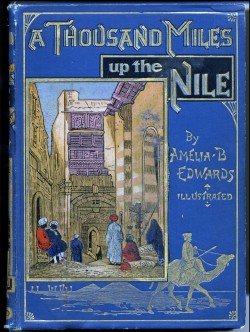 |
A
Thousand Miles Up the Nile
London, 1890
National Museum of African Art Library |
Amelia
Blanford Edwards (1831-1892)
The
truth is, however, that the mere sight-seeing of the Nile
demands some little reading and organizing, if only to be
enjoyed. We cannot all be profoundly learned; but we can at
least do our best to understand what we see--to get rid of
obstacles--to put the right thing in the right place. (from
A Thousand Miles Up the Nile)
Amelia Blanford Edwards' work emphasized the importance of
properly excavating and preserving Egyptian antiquities. During
a trip to Egypt in 1873-1874, Edwards, a British citizen who
began her career as a popular novelist, became so fascinated
by the country that she devoted the remainder of her life
to the study of its history and antiquities. Edwards instilled
in her readers an appreciation and respect for Egypt and its
culture. First published in 1877, A Thousand Miles Up the
Nile appeared in numerous editions, as recently as 1993. Intended
to give Western visitors to Egypt, whether scholars or tourists,
enough background information to enrich their understanding
of the places and things they saw, American visitors to Egypt
regularly consulted her book.
|
|
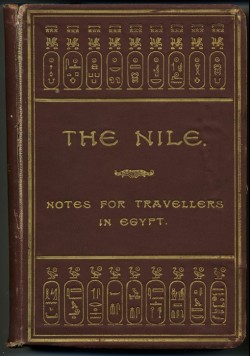
|
The
Nile: Notes for Travellers in Egypt
London, 1901
National Museum of African Art Library |
Ernest
Alfred Thompson Wallis Budge
Americans
who were interested in the antiquities and culture of Ancient
Egypt found this book by Ernest Budge, Keeper of Egyptian
and Assyrian Antiquities at the British Museum, to be a very
useful guide. Budge, who spent many archaeological seasons
in Egypt and West Asia between 1886 and 1913, wrote a number
of books on Egyptian antiquities as well as the autobiographical
work, By Nile and Tigris, published in 1920. The volume
displayed here was published by the London travel firm of
Thomas Cook and Son and presented to all travelers on Nile
cruises that were arranged through the Cook agency. |
|
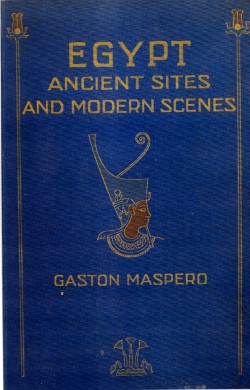
|
Egypt:
Ancient Sites and Modern Scenes
New York, 1911
National Museum of African Art Library |
Gaston
Camille Charles Maspero (1846 - 1916)
American
travelers read works by Maspero, director of Egypt's Antiquities
Service, who wrote a number of popular books as well as scholarly
treatises on Egypt. One of the nineteenth century's greatest
Egyptologists, the French-born Maspero was responsible for
securing Egypt's archaeological treasures for the Egyptian
Museum in Cairo. The book shown here, a translation of his
Ruins et paysages d'Égypte (1910), was popular
with visitors to Egypt.
|
|
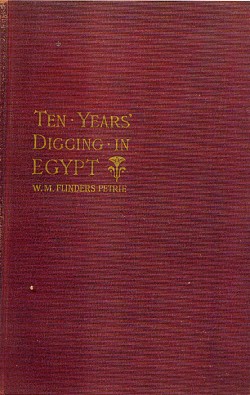
|
Ten
Years' Digging in Egypt 1881-1891
New York, 1892
Anthropology Library |
William
Matthew Flinders Petrie (1853 - 1942)
One
of the great British archaeologists in Egypt, Petrie helped
to define the modern discipline of Egyptology. He was an early
member of the Egyptian Exploration Society and a professor
at the University of London. He wrote popular works read by
a wide audience including this account of the daily life of
an archaeologist in Egypt. |
|



